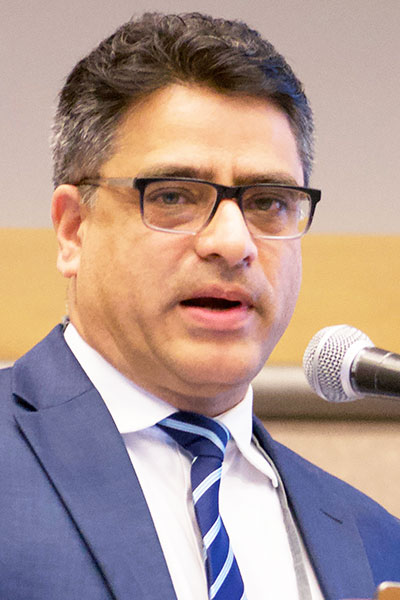Approaches to the management of patients with sarcoidosis can sometimes be as heterogeneous as the disease itself. During CHEST 2025, three experts shared their perspectives and best practices for decisions throughout a patient’s case in Sarcoidosis Management: A Case-Based Approach From Diagnosis to Transplant on Wednesday, October 22, in Chicago.
Biopsy and starting treatment

Ennis James, MD, Associate Professor of Medicine and Program Director of the Susan Pearlstine Sarcoidosis Center of Excellence at the Medical University of South Carolina, reviewed considerations for performing a biopsy and starting treatment for sarcoidosis.
Two questions can help clinicians determine if a patient needs a biopsy, Dr. James said. First, is the presentation considered highly compatible with sarcoidosis? Second, does the patient have asymptomatic hilar adenopathy? If the answer to both questions is no, then the patient should undergo a biopsy to confirm the diagnosis and exclude other causes.
The next step is determining what to biopsy. The 2020 American Thoracic Society guidelines recommend bronchoscopy with endobronchial ultrasound-guided transbronchial needle aspiration (EBUS-TBNA) in patients with lung disease and adenopathy. Even patients with typical sarcoid skin lesions confirmed by biopsy showing granulomas should still undergo bronchoscopy to exclude other possible causes, Dr. James said.
“You can’t forget the third and most important part of making a diagnosis of sarcoidosis, which is exclusion of other causes,” he said.
Initiation of prednisone treatment for pulmonary sarcoidosis should be considered in symptomatic patients with quality-of-life impairments and in those believed to be at higher risk of future mortality or permanent disability from sarcoidosis, Dr. James said.
Escalating or changing therapy

Nancy Lin, MD, Assistant Professor of Pulmonary and Critical Care Medicine at Johns Hopkins Medicine, discussed the approach to escalating and modifying therapies in sarcoidosis.
One of the main reasons to escalate or change treatment is if a patient is having persistent symptoms despite adequate treatment, Dr. Lin said. However, it’s important to ensure there’s no secondary process contributing to those symptoms before initiating second-line therapy. Further, the diagnosis of sarcoidosis should be confirmed before initiating second-line therapy. Other reasons to change or escalate therapy are if the patient is having worsening organ damage, if the patient is unable to wean off steroids, or if there are intolerable steroid side effects.
“Studies have shown that up to 74% of patients relapse after being weaned off of steroids. In the people that I see in my sarcoidosis clinic, it’s not uncommon that they will need a second-line agent,” said Dr. Lin, who also outlined dosing and side effect considerations for specific second-line and third-line therapies.
Referral to lung transplant

Session Chair Hakim Azfar Ali, MD, MPH, FCCP, Associate Professor of Medicine and Director of the Pulmonary Sarcoidosis Clinic at Duke University Hospital, discussed indications and timing for lung transplantation in patients with sarcoidosis.
Lung transplantation should be considered for adults with chronic, end-stage lung disease who have a greater than 50% risk of death within two years without transplant and a greater than 80% likelihood of five-year posttransplant survival, Dr. Ali said.
Referral for lung transplantation should be considered when a patient has pulmonary fibrosis with a vital capacity of less than 80% or diffusion less than 40% or fibrosis plus a two-year decline of 10% to 15% in these numbers, he said. Referral should also be considered in patients who require any oxygen supplementation and who have radiological or symptomatic progression.
Importantly, few absolute contraindications to lung transplantation exist, and many factors that were once considered contraindications are now considered risk factors, Dr. Ali said. Lung transplantation will not be considered in patients with active malignancy, untreatable central nervous system dysfunction, other organ dysfunction, noncurable infections, uncorrectable bleeding diathesis, acute medical instability, or psychiatric conditions that impair care or nonadherence. “There are so many different considerations when you see patients for transplant,” Dr. Ali said. “There are disease-specific considerations and treatment-related effects that will need to be considered when you refer them, and that’s why early referral makes sense for this population.”

Call for Topics Is Open
Feeling inspired by all the great sessions in Chicago? Help shape the curriculum for CHEST 2026, October 18 to 21 in Phoenix, by submitting topic ideas from areas you’re passionate about, topics affecting your practice, or new technologies you’d like to learn more about. The submission deadline is Tuesday, December 2, at 2 pm CT.


